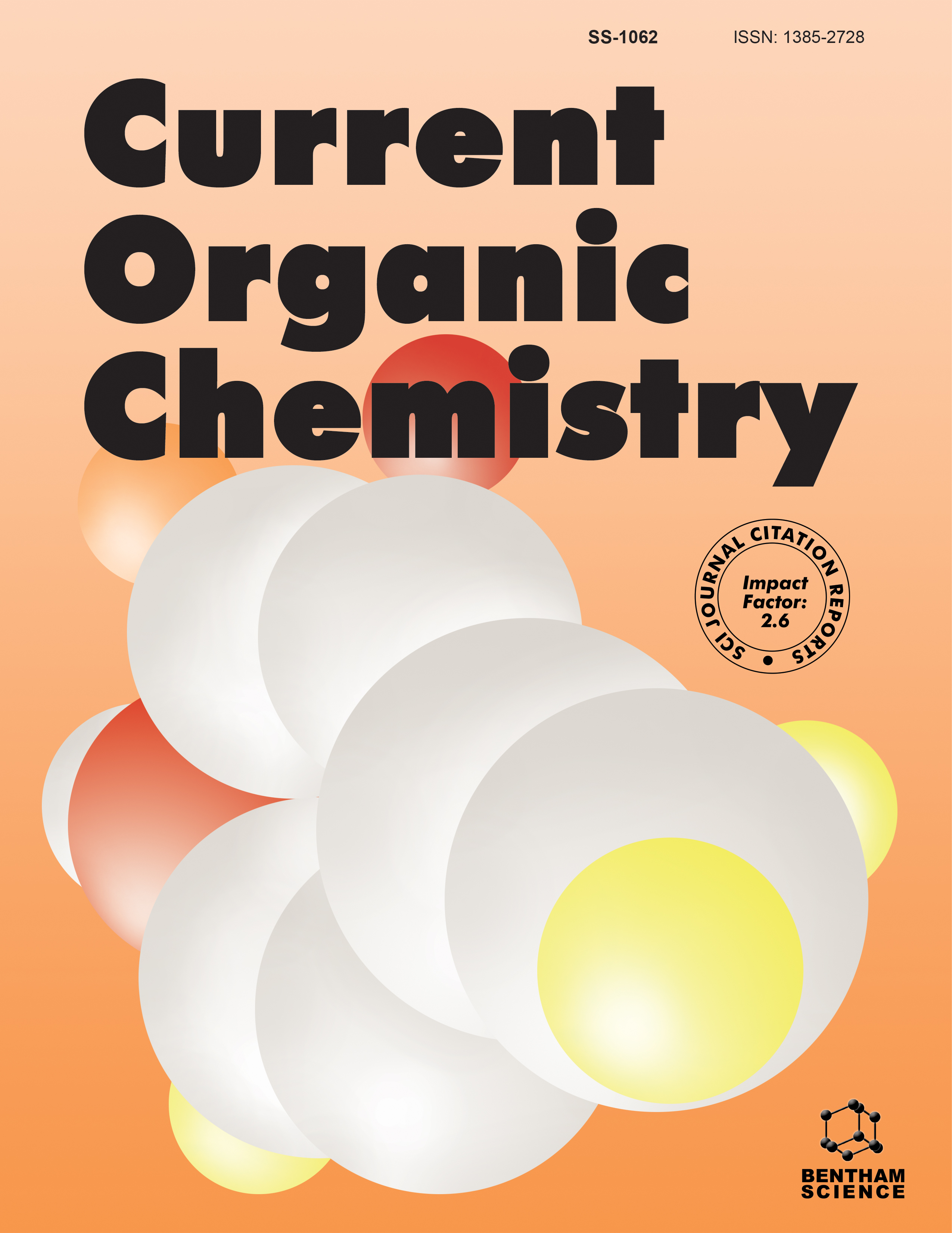- Home
- A-Z Publications
- Current Organic Chemistry
- Previous Issues
- Volume 18, Issue 7, 2014
Current Organic Chemistry - Volume 18, Issue 7, 2014
Volume 18, Issue 7, 2014
-
-
Natural Products with Health Benefits from Marine Biological Resources
More LessOcean is the cradle of lives, which provides a diverse array of intriguing natural products that capture scientists’ great attention in the past few decades due to their significant and extremely potent biological activities. In addition to being rich sources for pharmaceutical drugs, marine natural products are increasingly recognized as sources in the discovery of functional foods and dietary supplements and provide useful Read More
-
-
-
Structure, Biological Properties and Utilities of Marine-derived Antimicrobial Peptides
More LessMarine organisms, as a rich recourse of numerous bioactive compounds, have been reported to produce antimicrobial peptides (AMP). Antimicrobial peptides are small molecular weight peptides which protect the host organisms against multiple microbes. Due to the non-toxicity, broad-spectrum antimicrobial activities and the ability to escape drug-resistance mechanisms, antimicrobial peptides are valued as a po Read More
-
-
-
Macrolactins: Antitumor Antibiotics as Marine Drug Lead
More LessAuthors: Tingting Wang, Shan He, Xiaojun Yan and Peng ZhuMacrolactins are secondary metabolites mainly from marine microorganisms bearing a unique 24-membered lactone core structure. Since their first occurrence in 1989, they have attracted considerable attention from natural product chemists, organic chemists, and pharmacologists due to their chemical complexity, potent antimicrobial and antitumor activities. Some of them are serving as lead compounds for drug discover Read More
-
-
-
Marine Toxin Structure Elucidation by Mass Spectrometry
More LessBy Pengyuan LiuMass spectrometry (MS) analysis plays an important role in the structural elucidation of natural marine toxins. In MS analysis, the chemical structural elucidation is mainly achieved by tandem MS (MS/MS) and multiple stage MS (MSn) techniques, in which fragmented product ions are used to interpret precursor ion structures. Herein we discuss the MS/MS and MSn behaviors of major marine toxins, such as domoic acid Read More
-
-
-
Quorum Sensing Inhibitors from the Sea: Lessons from Marine Symbiotic Relationships
More LessAuthors: Mariana C. Chifiriuc, Alexandru M. Grumezescu and Veronica LazarThe over-prescription and misuse of microbiostatic or microbicidal chemical compounds led to the emergence of antibiotic resistance and multiresistance in bacterial strains. The genetic resistance of bacterial cells is amplified when they are growing in biofilms, known for the high phenotypic resistance or tolerance to antimicrobial agents, explaining their high incidence in the etiology of infectious diseases. Currentl Read More
-
-
-
Terpenoids form the Sea: Chemical Diversity and Bioactivity
More LessBy Kuiwu WangMarine organisms are a rich source of biologically active terpenes. Some of them exhibit antiviral, antifouling, antitumor, antimicrobial, antifungal, activities. The present paper reviews the latest progress in the chemistry and pharmacological activities of terpenoids from marine organisms.
-
-
-
Design Polysaccharides of Marine Origin: Chemical Modifications to Reach Advanced Versatile Compounds
More LessAuthors: Nathalie Chopin, Xavier Guillory, Pierre Weiss, Jean L. Bideau and Sylvia Colliec-JouaultPolysaccharides are among the most abundant macromolecules on Earth. These polymers are easily obtained from various marine resources such as algae, microorganisms and crustacean shells. The structure of these natural carbohydrates is innovative and quite complex. Marine biopolymers represent key scaffolds toward large challenging fields, such as biomedical applications (glycosaminoglycans, regenerative medicine an Read More
-
-
-
Bioproducts from Seaweeds: A Review with Special Focus on the Iberian Peninsula
More LessSeaweeds, i.e. macroalgae that occupy the littoral zone, are a great source of compounds with diverse applications; their types and content greatly determine the potential applications and commercial values. Algal polysaccharides, namely the hydrocolloids: agar, alginate and carrageenan, as well as other non-jellifying polysaccharides and oligosaccharides, are valuable bioproducts. Likewise, pigments, proteins, amino acids an Read More
-
-
-
The Potential Biomedical Application of Cyclopeptides from Marine Natural Products
More LessBy Yuping ZhouThe largely unexplored marine would represent a unique and excellent resource of new natural products. The chemical and biological diversity of the marine environment formed a practically unlimited resource of new bioactive substances. Marine natural products captured the attention of natural products chemists because they exhibit significant and extremely potent biological activities. With the development of technologi Read More
-
-
-
Stress-driven Discovery of Natural Products from Extreme Marine Environment- Kueishantao Hydrothermal Vent, a Case Study of Metal Switch Valve
More LessAuthors: Wei Jiang, Yuqian Zhong, Li Shen, Xiaodan Wu, Ying Ye, Chen-Tung A. Chen and Bin WuMarine hydrothermal vent microbial habitats are strongly influenced by elevated levels of heavy metals. Hydrothermal microorganisms respond rapidly to the changes in the concentrations and availability of metals within their environment, where geothermally heated water reacts with its host rock forming fluids that nourish a diverse array of geothermally dependent microorganisms. Most marine fungi possess a remarka Read More
-
Volumes & issues
-
Volume 29 (2025)
-
Volume 28 (2024)
-
Volume 27 (2023)
-
Volume 26 (2022)
-
Volume 25 (2021)
-
Volume 24 (2020)
-
Volume 23 (2019)
-
Volume 22 (2018)
-
Volume 21 (2017)
-
Volume 20 (2016)
-
Volume 19 (2015)
-
Volume 18 (2014)
-
Volume 17 (2013)
-
Volume 16 (2012)
-
Volume 15 (2011)
-
Volume 14 (2010)
-
Volume 13 (2009)
-
Volume 12 (2008)
-
Volume 11 (2007)
-
Volume 10 (2006)
-
Volume 9 (2005)
-
Volume 8 (2004)
-
Volume 7 (2003)
-
Volume 6 (2002)
-
Volume 5 (2001)
-
Volume 4 (2000)
Most Read This Month
Article
content/journals/coc
Journal
10
5
false
en


